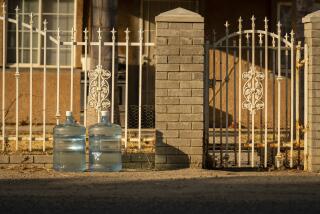Cost of Fixing Tollway Drains Is $13.3 Million
Caltrans estimates it will cost at least $13.3 million to repair or replace 38 storm drain filters along the San Joaquin Hills toll road that the agency has conceded are faulty and should never have been installed in the first place.
The hefty price tag is roughly 15 times what it cost to install the existing filters, which Caltrans acknowledged this year were not working.
The agency, which estimates it would cost $1 million a year to maintain the faulty filters and faces stiff fines if it does not comply with a state cleanup order, said it is trying to resolve the situation as quickly as possible.
Since the 20-mile tollway from Newport Beach to San Juan Capistrano opened in 1996, sediment and debris have collected on the filters, rendering them useless and sending polluted runoff onto surrounding lands. Contaminants in the runoff include lead from vehicle exhaust, copper dust from brakes and oil leaking from cars and trucks. In some cases, tests have shown that water going into the drains came out more tainted than when it went in.
The ambitious proposal presented to state water regulators seeks to fix three of the filters in time for the traditional start of the rainy season next month, and replace or retrofit the remaining 35 drains with seven types of treatment systems by 2004.
“This timeline is an aggressive yet realistic goal for Caltrans,” according to a report submitted to the water board by Caltrans.
The plan is another chapter in the long history of the toll road, which was built despite fierce opposition from environmentalists and residents. The San Diego Regional Water Quality Control Board must give final approval. Water board officials said Friday they had just begun to investigate whether the plan will work.
“That’s the big question,” said Christopher Means, an environmental specialist overseeing the project for the regulatory agency. “Until I look into these things a little bit more, I’m not going to be able to say whether we’re signing off one way or another. We have a lot more work to do to dissect this thing.”
In July, the water board ordered Caltrans to draw up a schedule for fixing the drains along the toll road, which passes through several major watersheds that drain into the ocean.
Although the toll road was financed and built by a joint-powers authority based in Irvine, Caltrans agreed to assume responsibility for the road’s operation and maintenance.
But in an internal report this year, Caltrans said the drains have never functioned properly and were not maintained because of the expense. That report said the filtering systems were thought to be suitable during the design and construction of the toll road.
Authorities said the filters were installed horizontally, not vertically, which allows sediment and pollutants to collect on top, creating an impervious layer over the drain.
The design was abandoned in 1998 because of the problem, according to the transportation agency’s internal study.
Caltrans proposes to fix the problems in three stages.
In the first phase, filters at Oso Creek, Aliso Creek and Laguna Canyon, parts of which already have been replaced, would be fully repaired at a cost of about $120,000 and ready for monitoring by this fall’s rainy season.
The second phase, which is expected to cost $8.2 million and be finished by spring 2003, calls for 19 of the filters to be replaced with new technology, such as chemical applications, catch basins and skimmers, depending mostly on the topography of the sites.
The final phase, during which 16 remaining filters would be replaced, is expected to cost about $5 million and take until spring 2004 because of a variety of constraints. For one, right of way issues need to be resolved. And Caltrans estimates it may need more than 400 permits to address archeological and environmental concerns.
Caltrans spokeswoman Rose Melgoza said Friday that all seven types of treatment systems have proven track records along highways in Los Angeles and San Diego counties.
Means disagreed, but he reserved judgment on any of the proposed solutions until he had a chance to review all of them. He estimated it will take at least a month to respond.
Water board officials characterized the plan as an important first step and praised Caltrans for taking aggressive steps to tackle the problem, pointing out how the agency already is meeting other directives such as initiating a maintenance and monthly inspection program.
“With all the constraints they have to go through, they seem to be moving at a fairly aggressive pace,” Means said. “They’re not shirking their responsibility.”
The agency faces an Oct. 30 deadline to put in place a monitoring program that determines runoff quality, the filters’ ability to remove contaminants and the likelihood that tainted water is polluting the ocean.
The order states that the runoff must be tested for 18 contaminants, including chromium, copper, lead and nickel.
If it violates the order, Caltrans could be fined $5,000 a day.
More to Read
Sign up for Essential California
The most important California stories and recommendations in your inbox every morning.
You may occasionally receive promotional content from the Los Angeles Times.










